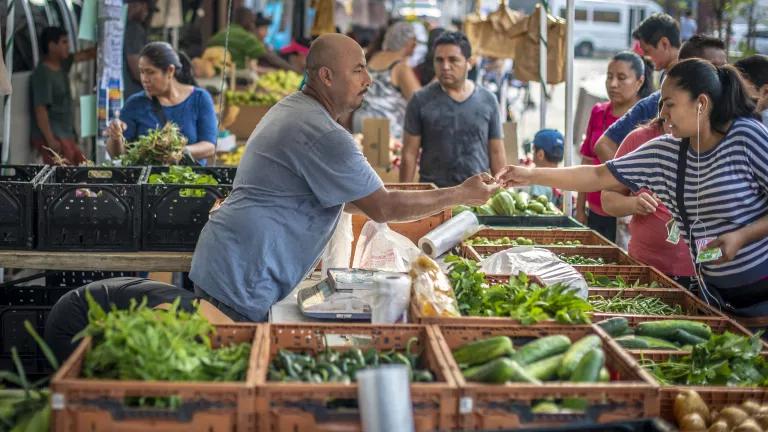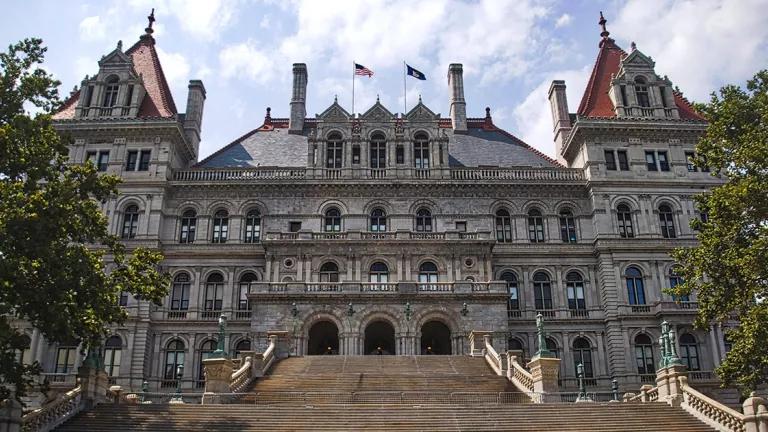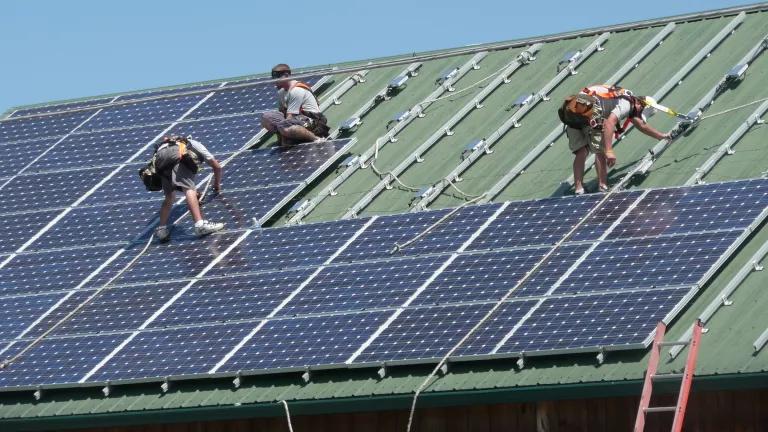New Yorkers Highlight Opportunities to Grow SNAP Incentives
SNAP incentives play an essential role in addressing challenges around fresh, healthy food affordability and access, provide much needed markets for local farmers, and drive local economic development.

Corona Farmers Market in Queens, New York
People of color and low-income people around the country are disproportionately exposed to environmental burdens. These inequalities are determinative of nearly all aspects of life, including whether families are food secure—meaning whether food is available in nearby, accessible stores, whether it is affordable, and whether it is culturally appropriate.
In New York, more than 10 percent of households are food insecure. Nationally, food insecurity is increasing, amidst inflation and waning Covid support programs. And Black and Latinx adults face food insecurity at disparately high rates – 29 and 32 percent, respectively, compared with 17 percent of white adults.
The federal Supplemental Nutrition Assistance Program (SNAP) provides money for food to individuals and households who meet certain eligibility criteria based on income. As of January 2023, SNAP serves over 42 million people in the United States. In New York, just over 2.8 million people rely on SNAP benefits—up 3.5 percent from last year. For the most recent fiscal year with data available, more than 54 percent of SNAP participants in New York were families with children, while almost 48 percent of New York SNAP users were in families with members who are seniors or disabled.
While SNAP is vital, this framework alone cannot satisfy the need for affordable, accessible, and healthy food for all. To truly fix the hunger crisis, we must address its root causes, including systemic racism, the racial wealth gap, and a food system that benefits corporations at the expense of low-income communities and communities of color.
Despite these systemic inequalities, there is still value in determining how best to strengthen and expand SNAP to ensure that all who are eligible can obtain benefits and use them to purchase healthy and culturally appropriate food. And it’s important to consider how these programs can be better used to build wealth in low-income communities.
Many states, including New York, have created SNAP incentive programs that increase the value of SNAP dollars when they are spent in certain ways, often at farmers markets. These programs offer states the opportunity to leverage federal funds to provide residents with additional money to purchase food, and to simultaneously support local farms and economies. The potential impact is significant, as each of the 2.8 million people in New York who use SNAP may be eligible for SNAP incentive programs, offering increased purchasing power for millions of low-income New Yorkers and harnessing a massive federal safety net for local economies.
Over the past two years, NRDC has gathered both experiential and quantitative data about where and how people use SNAP incentives in New York—and what factors might limit the success of these programs. This is the first in a series of blogs sharing NRDC’s findings, starting with themes from a series of interviews conducted with New Yorkers who have experience navigating SNAP and SNAP incentive programs, ranging from staff at community gardens and local pantries to college students and farmers market managers.
SNAP Incentive Programs in New York State
There are three primary SNAP incentive programs that operate in New York – Field and Fork’s Double Up Food Bucks, New York City’s Health Bucks, and New York State’s Fresh Connect Checks. These three programs differ in how they are funded, how they operate, and what geographies they serve within the state. The interview reflections touch on the overall experience of using SNAP incentives in New York rather than any one specific program.
While this blog focuses on the SNAP incentive program experience in New York, we heard repeatedly about threshold issues with the federal SNAP program and how it is administered in New York—including significant barriers to enrollment and ease of use in retail environments. These challenges spill over into and limit the efficacy of SNAP incentive programs in the state, but they are not the topic of this specific blog. We strongly support improvements to the SNAP program at the federal and state level – as called for by numerous community-based and national organizations.
SNAP Incentive Programs Help Promote Food Security
New Yorkers want to buy fresh, healthy foods
In interviews about SNAP and SNAP incentive programs, we heard repeatedly that community members who use these benefits are interested in eating fresh fruits and vegetables. As Valerie, a project coordinator for a university advocacy group, said, “There’s this misconception that poor people don't want to eat vegetables and that's not true. Why would people think that? Everyone wants to eat vegetables, like some people might have preferences on what kinds of vegetables or how they’re prepared….” Similarly, Finn Brigham at Callen-Lorde Center described the excitement people expressed at having access to fresh produce. “I think when I would tell patients that they could use their SNAP benefits, it was like their faces would light up and they’d run and grab their card because they just thought there was something that they couldn’t access or they couldn’t afford.” These programs are powerful tools in increasing the purchasing power of low-income shoppers, helping more families afford the fruits and vegetables they want to eat.

Fresh vegetables at the Union Square Farmers Market in Manhattan, New York
SNAP benefits alone are not meeting household need
Federal SNAP benefits alone are simply not sufficient to meet users’ needs. Despite small but meaningful increases in SNAP benefits following the 2021 update of the Thrifty Food Plan, many SNAP recipients struggle to afford fresh fruits and vegetables. We repeatedly heard through interviews that cost is a barrier to purchasing produce, and this bears out in data at the national level as well. Abigail, who manages programming at a culinary community center, explained that “affordability remains a central barrier to purchasing fresh fruits and vegetables. There are many times that the benefits are not enough to purchase produce for the whole month or purchase for a household of 2, 3, 4 people.” A farmers market manager in the Bronx put it clearly, stating “I really think people don’t get enough SNAP benefits. And I see when people can buy more vegetables, they buy more vegetables...If [they] don’t have the money to eat well, they aren’t going to eat well.”
One market manager shared insight from the retailer perspective, illustrating how consistently insufficient benefits limit families’ abilities to purchase food. As she described it, “EBT cards are loaded at the beginning of the month, so a significant amount of people come to the market at the beginning of the month, but by the end of the month there is much lower foot traffic.”
With SNAP users demonstrating a strong interest in purchasing fruits and vegetables, and real limitations around affordability of these products, SNAP incentives offer a way for low-income families to purchase more fresh produce. At the same time, SNAP incentive programs also hold enormous potential for local farmers and economies.
New York’s SNAP Incentive Programs Are Not Meeting Their Full Potential
Many potential program beneficiaries are unaware of SNAP incentive programs
The interviews highlighted that many New Yorkers are not aware of SNAP incentive programs, both at an organizational and individual level. Despite working in food and food related organizations in low-income communities, a number of the people we spoke with were simply not familiar with any of the SNAP incentive programs operating in New York. Others were aware of one or more SNAP incentive programs but felt that many of their community members were not familiar with the programs and that their organizations lacked the resources to meaningfully spread the word about SNAP incentives. Several people suggested that more outreach – in accessible and multilingual formats—to low-income communities and community-based organizations about these powerful programs could go a long way in increasing their use.
SNAP incentive programs can be cumbersome to use and to administer
Individuals who are well-versed in New York’s SNAP incentive programs shared that the way the programs are currently administered presents several challenges for consumers and retailers alike.
First, the relative complexity of the program details (e.g., how many incentives you get per SNAP dollar spent, what products the incentives can be used to purchase, etc.) can make it hard for customers to understand the programs and for retailers to administer them. Elizabeth Winn, the Food Access Coordinator for Kingston Farmers Market, explained, “A big challenge that we face, [is] just not having enough people trained to run the [SNAP and SNAP incentive] services that we provide,” adding that it’s a matter of “really understanding what they’re utilizing and then…really just not having enough hands to feel like it can run smoothly.” Clearly explaining how SNAP incentive programs work to customers isn’t easy, especially when people are rushing to do their shopping or if there is a language barrier. This problem is exacerbated if markets shift between two different incentive programs, either from year to year or over the course of a season, or offer two similar but slightly different incentives (e.g., offering a farmers market nutrition program coupon that is not directly tied to SNAP benefits).
Second, programs relying on physical vouchers like paper coupons or tokens can be difficult to manage. At a farm market in the South Bronx, the market manager found SNAP incentive coupons quite cumbersome, both for the market and the customer. Paper coupons can require complicated record keeping for the market, creating unnecessary administrative hurdles during busy market times, especially when juggling multiple incentive programs. Additionally, customers do not always use their SNAP incentives the same day they accrue, making it more likely that families will misplace the physical vouchers or forget to bring them to the market on their next visit.
Several people interviewed who are familiar with the programs suggested that having SNAP incentives loaded back onto beneficiaries’ Electronic Benefit Transfer cards would simplify things for customers and retailers. This meaningful improvement has been made successfully in other states.
When designed in partnership with the communities that rely on these programs, SNAP incentives play an essential role in addressing challenges around fresh, healthy food affordability and access, provide much needed markets for local farmers, and drive local economic development. The next blog in this series will examine disparities in geographic access to SNAP incentives across New York State.
This blog is the first in a series sharing themes and lessons learned from the Natural Resources Defense Council's research on SNAP and SNAP incentive programs in New York State over the past two years. We thank our consultants, QJM Multiprise and Five Points Geoplanning, plus many community members for their important insights that informed this work. Please note that some names have been shortened or omitted to protect the privacy of the individuals interviewed for this blog series.






